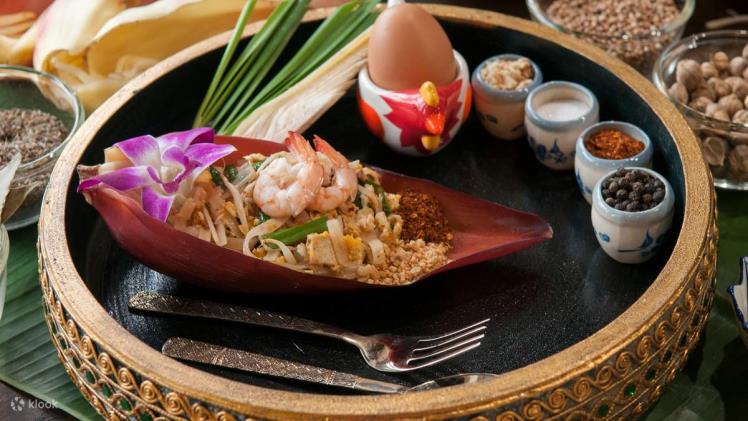Thailand, often referred to as the Land of Smiles, is not only known for its breathtaking landscapes and warm hospitality but also for its exquisite and diverse cuisine. Thai food is celebrated globally for its harmonious blend of flavors, vibrant colors, and aromatic herbs and spices. Embarking on a culinary journey through Thailand is like stepping into a world where every meal is a symphony of tastes and textures, a delightful exploration of flavors that can satisfy every palate.
The Essence of Thai Cuisine
At the heart of Thai cuisine lies a philosophy that balances four essential tastes: sweet, sour, salty, and spicy. This unique culinary concept creates dishes that are not only delicious but also incredibly well-balanced. Let’s delve into the key elements that define Thai cuisine:
- A Symphony of Spices: Thai cuisine is famous for its bold and aromatic use of spices and herbs. Ingredients like lemongrass, galangal, ginger, and Thai basil add layers of depth and complexity to dishes. Chili peppers are another staple, and they range from mild to fiery hot, giving diners the option to customize their spice levels.
- Freshness is Key: Thai food is characterized by its freshness, and this is particularly evident in dishes like Som Tum (green papaya salad) and Tom Yum (spicy sour soup). The use of fresh herbs, vegetables, and proteins results in dishes that burst with vibrant flavors and textures.
- Street Food Culture: No culinary journey through Thailand would be complete without exploring the street food culture. Thai street vendors whip up an array of delectable dishes, from Pad Thai (stir-fried noodles) to Satay (grilled skewers) to Mango Sticky Rice. These affordable and flavorful treats are a testament to the country’s culinary prowess.
Regional Diversity
Thailand’s culinary landscape is as diverse as its geography. The country can be divided into four main culinary regions, each with its own distinct flavors and specialties:
- Northern Cuisine: Northern Thai cuisine is characterized by milder flavors and heavy use of herbs and vegetables. Dishes like Khao Soi (curry noodle soup) and Sai Oua (spicy sausage) are regional favorites.
- Northeastern Cuisine (Isaan): Isaan cuisine is known for its bold and spicy flavors. Sticky rice, grilled meats, and dishes like Som Tum (spicy papaya salad) are staples in this region.
- Central Cuisine: The central region, including Bangkok, is where you’ll find the famous Thai street food. Pad Thai, Tom Yum, and Green Curry are all popular dishes hailing from this region.
- Southern Cuisine: Southern Thai cuisine is renowned for its intense spiciness and bold flavors. Dishes like Massaman Curry and Gaeng Som (sour curry) showcase the culinary diversity of this region.
Must-Try Thai Dishes
Pad Thai: Perhaps one of the most famous Thai dishes worldwide, Pad Thai is a stir-fried noodle dish made with rice noodles, shrimp, tofu, eggs, and a flavorful sauce. It’s garnished with crushed peanuts, lime wedges, and fresh herbs.
Tom Yum Goong: This iconic Thai soup is a spicy and sour masterpiece. It features shrimp, mushrooms, lemongrass, and a blend of aromatic herbs and spices in a clear or creamy broth.
Green Curry: Thai green curry is a creamy and fragrant curry made with green chili paste, coconut milk, and a variety of vegetables and proteins. It’s often served with jasmine rice.
Som Tum: This refreshing and spicy green papaya salad is a staple in Isaan cuisine. It combines shredded green papaya with chili peppers, lime juice, fish sauce, and peanuts.
Mango Sticky Rice: A delightful Thai dessert, mango sticky rice features sweet glutinous rice topped with ripe mango slices and drizzled with coconut milk.
Thai Food Beyond Borders
Thai cuisine has gained international acclaim, and you’ll find Thai restaurants in almost every corner of the globe. Thai chefs and home cooks alike have adapted traditional recipes to suit different palates while preserving the essence of Thai flavors.
Food enthusiasts can explore Thai cuisine in various ways, from taking cooking classes in Thailand to experimenting with Thai ingredients and recipes at home. The availability of Thai ingredients, such as coconut milk, fish sauce, and curry pastes, in most supermarkets makes it easy to bring the taste of Thailand to your kitchen.
In Conclusion
A culinary journey through Thailand is a sensory adventure like no other. From the bustling street food stalls of Bangkok to the serene riverside restaurants of Chiang Mai, the flavors of Thai cuisine never cease to amaze and delight. Thai food is a testament to the country’s rich culture, heritage, and the passionate artistry of its people. So, the next time you savor a plate of Pad Thai or sip on a bowl of Tom Yum, remember that you’re experiencing the magic of Thailand through its incredible culinary traditions.


